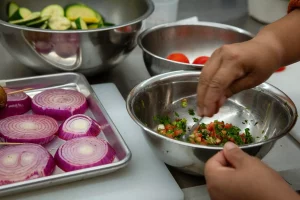Introduction: Meet Yotam Ottolenghi, the Chef Championing Healthy School Lunches In the realm of culinary innovation, few names carry as much weight as Yotam Ottolenghi. Renowned for his emphasis on Middle Eastern and Mediterranean flavors, Ottolenghi has become a leading figure in the global food scene. However, his influence extends far beyond the walls of
Introduction: Meet Yotam Ottolenghi, the Chef Championing Healthy School Lunches
In the realm of culinary innovation, few names carry as much weight as Yotam Ottolenghi. Renowned for his emphasis on Middle Eastern and Mediterranean flavors, Ottolenghi has become a leading figure in the global food scene. However, his influence extends far beyond the walls of his restaurants and cookbooks. Ottolenghi has taken up the noble cause of transforming school lunches, advocating for a farm-to-table approach that prioritizes fresh, nutritious ingredients over processed fare. In this article, we delve into the farm-to-table movement and bid farewell to the era of chicken nuggets in school cafeterias. Join us as we explore the evolution of school meals, the benefits of embracing fresh ingredients, and the strategies for implementing this transformative shift. Whether you’re a parent or an educator, this article offers practical insights and inspiration for creating healthier and more sustainable school lunch programs.
The Farm-to-Table Movement: A Paradigm Shift in School Lunches
Over the past decade, the farm-to-table movement has gained significant traction in the culinary world. This approach emphasizes sourcing ingredients directly from local farms, promoting sustainable agriculture, and reducing the carbon footprint associated with food production and transportation. While initially popularized in high-end restaurants, the farm-to-table philosophy has found its way into school lunchrooms, sparking a revolution in the way we nourish our children.
From Processed to Fresh: The Benefits of Farm-to-Table School Meals
One of the primary advantages of farm-to-table school meals lies in the quality of ingredients. Instead of relying on low-grade meat and additives, these meals prioritize fresh, locally sourced produce and whole foods. By incorporating nutrient-rich ingredients, such as fruits, vegetables, whole grains, and lean proteins, farm-to-table lunches provide children with the essential nutrients they need for optimal growth and development. This shift away from processed foods also helps combat childhood obesity and promotes healthier eating habits.
Nurturing Young Palates: Introducing Diverse Flavors and Ingredients
Another significant aspect of the farm-to-table approach is the introduction of diverse flavors and ingredients to young palates. By incorporating a variety of cultural cuisines and seasonal produce, school lunches become an opportunity for children to explore new tastes and expand their culinary horizons. This exposure to diverse flavors not only enhances their dining experience but also encourages a lifelong appreciation for different cuisines and healthy eating habits.

Image by: https://napavalleyregister.com/news/state-regional/california-school-lunch-health/article_fda4682a-386b-11ee-859e-7b7a54cde385.html
Local Sourcing: Supporting Communities and Sustainable Agriculture
One of the core principles of the farm-to-table movement is supporting local farmers and fostering connections within the community. By sourcing ingredients from nearby farms, schools contribute to the local economy and help sustain small-scale agricultural practices. Additionally, this approach reduces the carbon footprint associated with long-distance transportation and supports environmentally sustainable farming methods. By embracing local sourcing, schools can play a vital role in promoting community resilience and environmental stewardship.
Overcoming Challenges: Implementing the Farm-to-Table Approach in Schools
While the farm-to-table movement holds immense promise, implementing this approach in schools does come with its fair share of challenges. Limited budgets, logistical constraints, and resistance to change can hinder the adoption of farm-to-table practices. However, with careful planning, collaboration with local farmers, and support from parents and educators, these obstacles can be overcome. The article provides practical tips and strategies for successfully implementing the farm-to-table approach in school lunch programs.
Success Stories: Schools Leading the Way in Farm-to-Table Lunch Programs
Across the country, schools are already leading the way in embracing the farm-to-table shift. From urban districts to rural communities, innovative school lunch programs are demonstrating the positive impact of fresh, locally sourced meals on student health and well-being. By highlighting these success stories, the article aims to inspire and empower other schools to follow suit, creating a ripple effect that transforms the landscape of school lunches nationwide.
Empowering Parents and Educators: Tips for Advocating for Change
Parents and educators play a crucial role in advocating for healthier school lunches. By actively engaging with school administrators, participating in parent-teacher associations, and organizing community initiatives, they can drive change and ensure that their children have access to nutritious meals. The article provides practical tips and guidance for parents and educators to become effective advocates for farm-to-table school lunch programs.
The Future of School Lunches: A Healthier and More Sustainable Path
As we look to the future, the farm-to-table movement offers a promising path for school lunches. By prioritizing fresh, locally sourced ingredients, we can nourish our children with meals that promote their health, support local communities, and protect the environment. With the guidance of culinary visionaries like Yotam Ottolenghi and the collective efforts of parents, educators, and policymakers, we can revolutionize school lunches and create a brighter, healthier future for our children.
Comparative Table: Processed Nuggets vs. Farm-to-Table Meals
| Features | Processed Nuggets | Farm-to-Table Meals |
|---|---|---|
| Ingredient Quality | Low-grade meat and additives | Fresh, locally sourced ingredients |
| Nutritional Value | High in unhealthy fats and sodium | Nutrient-rich, balanced meals |
| Flavor Diversity | Limited options and bland taste | Diverse flavors and cultural cuisines |
| Environmental Impact | High carbon footprint due to processing and packaging | Reduced carbon footprint through local sourcing |
| Health Consciousness | Unhealthy and contributing to childhood obesity |
Table: Key Points of the Farm-to-Table Shift in School Lunches
| Key Points | Description |
|---|---|
| Fresh Ingredients | Emphasis on locally sourced, seasonal produce and whole foods |
| Nutritional Benefits | Increased access to nutrient-rich meals, promoting healthier eating habits |
| Diverse Flavors | Introducing children to a variety of flavors and cultural cuisines |
| Community Support | Supporting local farmers and fostering connections within the community |
| Environmental Sustainability | Reducing carbon footprint through sustainable agricultural practices |
| Educational Opportunities | Teaching children about food origins, nutrition, a |
In conclusion
the farm-to-table shift in school lunches represents a paradigm shift in how we nourish our children. By embracing fresh, locally sourced ingredients, we can provide them with nutrient-rich meals, introduce diverse flavors, support local communities, and foster a love for healthy eating. With the guidance of culinary experts like Yotam Ottolenghi and the dedication of parents and educators, we can transform school lunch programs and pave the way for a healthier and more sustainable future. Let us bid farewell to processed nuggets and welcome a new era of farm-to-table school lunches.

















Leave a Comment
Your email address will not be published. Required fields are marked with *